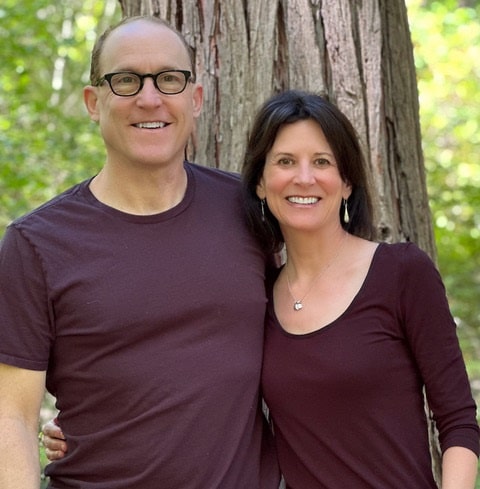
Co-Writing a Murder Mystery
Midge Raymond
While all fiction writers need beta readers and editors, most of us write solo. Yet sometimes a shared idea can lead to a shared writing project—and, if the project in question is a mystery novel, how can you be sure that the murder stays on the page?
My husband, John Yunker, and I decided to co-author our suspense novel, Devils Island, after a trip to Tasmania inspired a story in which six hikers embark on a glamping trip that goes horribly awry. While we are both published authors who’ve read each other’s work countless times, we’d never written together before—and here are some of the things we learned along the way.
Know your strengths (and weaknesses)
One reason John and I read each other’s work is that we both have different strengths as writers, and being each other’s first reader is helpful for our individual projects. It has also turned out to be useful for writing together. John is great at seeing the big picture of a story, whereas I can’t see the forest for the trees. I’m very detail oriented, whereas he will give six characters the same name (spelled eight different ways). Or he’ll change the names of characters or businesses during the course of a novel for no particular reason. He has even killed off a character, only to bring that character back to life, unwittingly, in the following chapter. Details are clearly not his thing. We’ve learned to embrace what we’re each good at and to let the other handle the aspects of writing the other does best.
Share the idea, share the work
Because we know what each of us brings to the page, when we began writing Devils Island, we could divide and conquer the tasks at hand in a way that made the writing not only stronger but more efficient. John tackled the outline, considering theme, plot, and subplots, and then we’d brainstorm until we were both happy with how the novel was shaping up. Then he drafted our first chapter, which, had this first step been up to me, would’ve taken a year rather than a matter of weeks. John next sent me a (very) rough draft, not bothering with the details that would only bog him down—and then I fleshed out the chapter with details of character and setting, making sure that each character’s hair color remained the same from one page to another and that no one was inexplicably beamed from the kitchen to the living room during the course of a conversation. And so it went, chapter by chapter, until we had a first draft.
Know when to bend
As with any shared endeavor, disagreements will happen—this is simply a healthy part of the collaborative process. Yet for writers who may be accustomed to writing alone and who have their own habits and preferences, constantly bending to the will of a co-writer can seem daunting.
But, going back to knowing your strengths, it helps to remember that you’ve partnered for a reason—not only to bring a shared vision to life but to make it the best it can be. Whenever John and I had a disagreement, we would argue our way out of it like a couple of lawyers making a case. Having to defend our work or advocate for making a change helped us see all sides of an issue, whether it was a scene, a subplot, or a certain character’s actions. Thinking and talking things through to this extent makes for a more solid book. In the end, it’s all about compromise.
Decide what’s in a name
Many factors go into deciding how to present shared work with the world. Famous writers will put both of their names on the cover for obvious reasons (why would Bill Clinton and James Patterson not use their fame to sell books?), but sometimes famous people like the freedom of a pen name. J.K. Rowling publishes crime fiction under the name Robert Galbraith “to work without hype or expectation and to receive totally unvarnished feedback,” as she tells readers on the Galbraith website. Yet her anonymity didn’t last long: The first Galbraith book was published in April of 2013, and Rowling’s identity was revealed three months later, at which point sales skyrocketed. Clearly, being a well-known author makes it worth having readers know your name—yet sometimes it helps even if you’re not famous.
As not-famous authors, John and I experimented with various pen names, having gotten feedback from a literary agent that a single pseudonym would make the publishing process less cumbersome—for example, having one name makes listing a book online or shelving it in a bookstore easier, and there’s less clutter on the cover. Yet when Devils Island found its home, our publisher thought it would be best to use our individual names because we each have something of a platform, and together we run a small press with a large mailing list. Having two names also makes promotion easier—for example, while we have a joint website and a shared Instagram account, we can also promote Devils Island via our individual social media accounts and email lists.
Enjoy the journey
In the end, what’s best about collaborating is dividing the work and doubling the joy (or halving the pain). When it comes to such things as revision and proofreading, John lets me handle these detail-oriented tasks that make his head spin. And because I’m rather technically averse, John built our website and handles design jobs like creating and printing our promotional postcards. Most of all, we aim to make the process fun. We hold meetings during happy hour and talk about plot during hikes in the forest. And now that we’ve both survived seeing one mystery to fruition, we’re already at work on the next one.
About the Author
Devils Island (Oceanview Publishing, September 2024) is the debut collaboration by the writing duo Midge Raymond and John Yunker, who are also co-founders of Ashland Creek Press. Midge is the author of the novels My Last Continent and Floreana and the award-winning short-story collection Forgetting English. John is the author of the novel The Tourist Trail and editor of the Among Animals fiction series and a nonfiction anthology, Writing for Animals. Visit them online at MidgeandJohn.com.

Similar Features
Querying a Mystery
How to Write a Query Letter That Won’t Get You Ghosted
Crafting the Character
Creating Characters as Mysterious as Your Plot
Subtext in Suspense Scripts
How Subtext Drives Suspense in Thrillers and Mysteries



